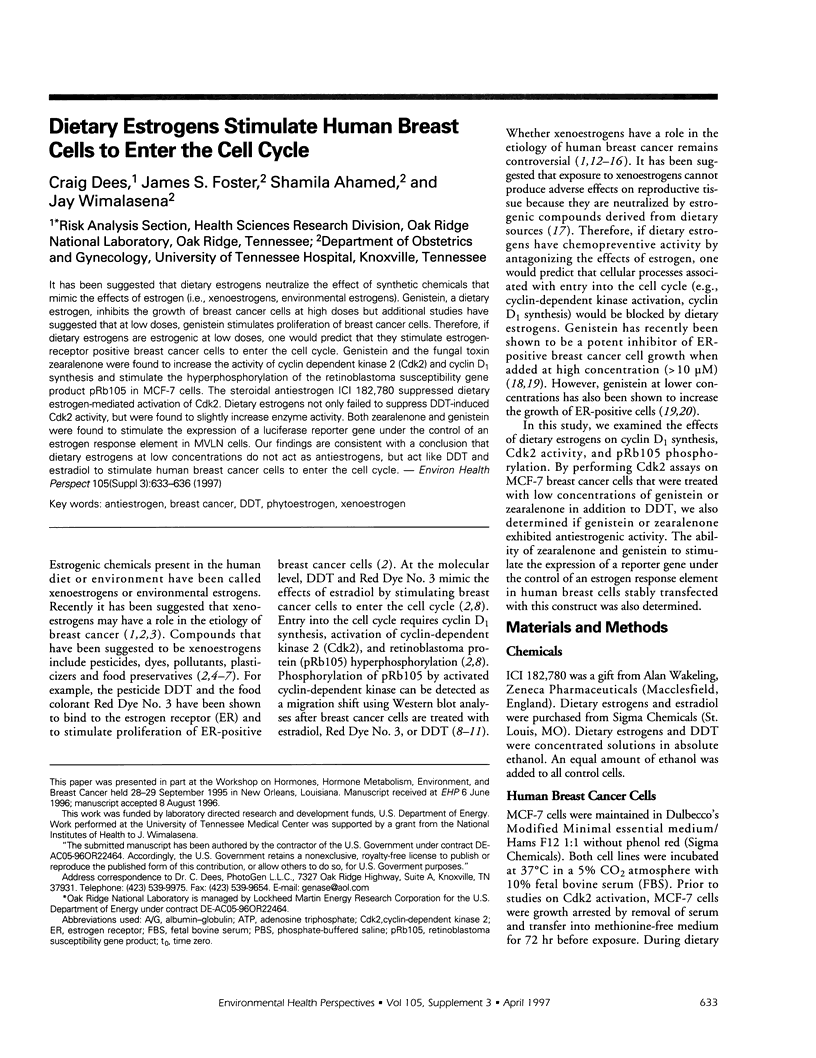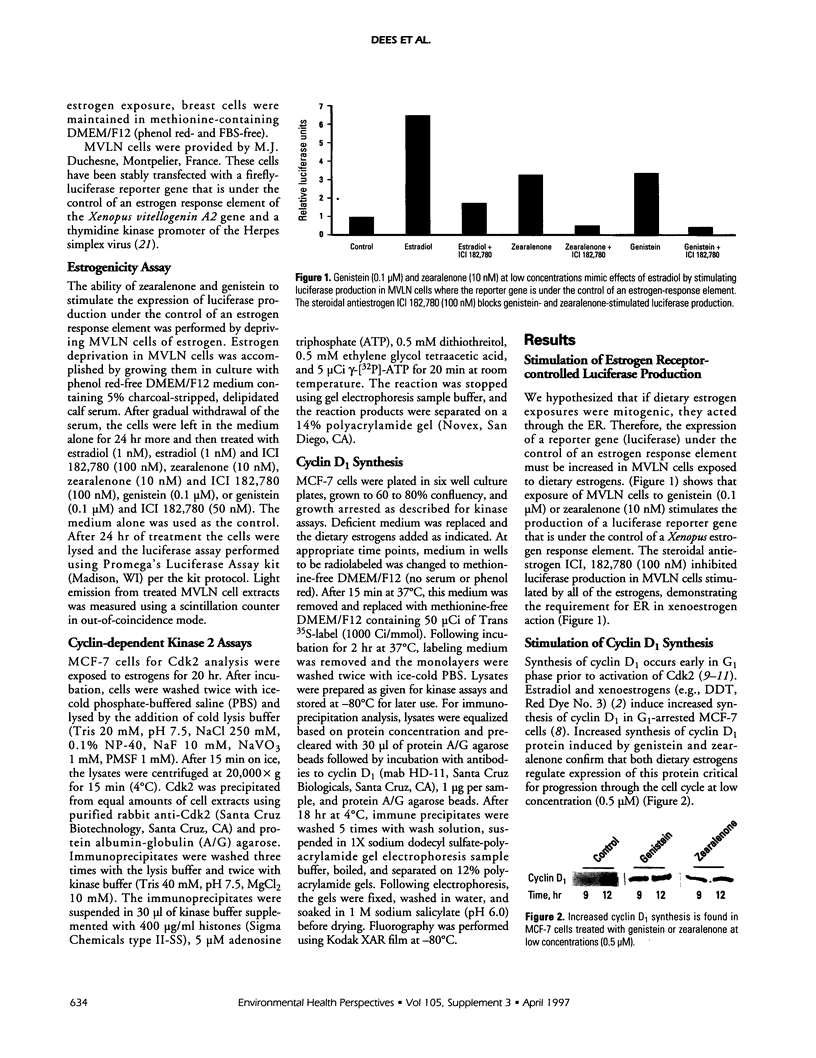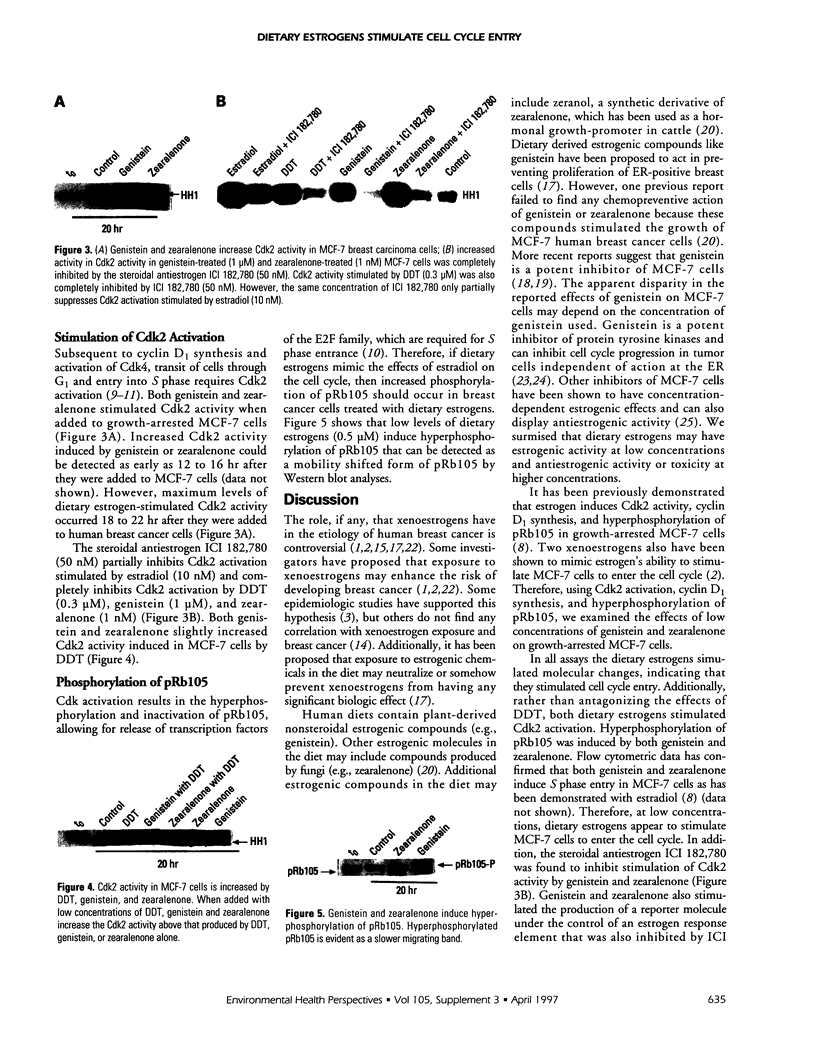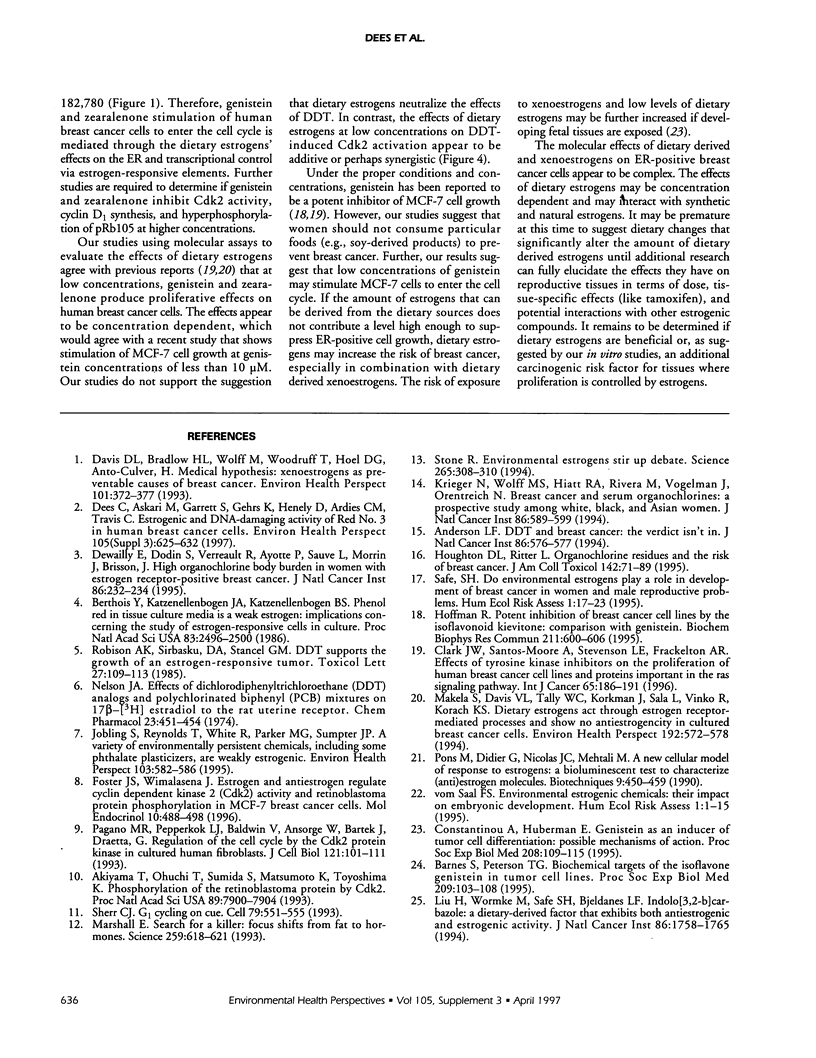Abstract
It has been suggested that dietary estrogens neutralize the effect of synthetic chemicals that mimic the effects of estrogen (i.e., xenoestrogens, environmental estrogens). Genistein, a dietary estrogen, inhibits the growth of breast cancer cells at high doses but additional studies have suggested that at low doses, genistein stimulates proliferation of breast cancer cells. Therefore, if dietary estrogens are estrogenic at low doses, one would predict that they stimulate estrogen-receptor positive breast cancer cells to enter the cell cycle. Genistein and the fungal toxin zearalenone were found to increase the activity of cyclin dependent kinase 2 (Cdk2) and cyclin D1 synthesis and stimulate the hyperphosphorylation of the retinoblastoma susceptibility gene product pRb105 in MCF-7 cells. The steroidal antiestrogen ICI 182,780 suppressed dietary estrogen-mediated activation of Cdk2. Dietary estrogens not only failed to suppress DDT-induced Cdk2 activity, but were found to slightly increase enzyme activity. Both zearalenone and genistein were found to stimulate the expression of a luciferase reporter gene under the control of an estrogen response element in MVLN cells. Our findings are consistent with a conclusion that dietary estrogens at low concentrations do not act as antiestrogens, but act like DDT and estradiol to stimulate human breast cancer cells to enter the cell cycle.
Full text
PDF



Images in this article
Selected References
These references are in PubMed. This may not be the complete list of references from this article.
- Akiyama T., Ohuchi T., Sumida S., Matsumoto K., Toyoshima K. Phosphorylation of the retinoblastoma protein by cdk2. Proc Natl Acad Sci U S A. 1992 Sep 1;89(17):7900–7904. doi: 10.1073/pnas.89.17.7900. [DOI] [PMC free article] [PubMed] [Google Scholar]
- Anderson L. F. DDT and breast cancer: the verdict isn't in. J Natl Cancer Inst. 1994 Apr 20;86(8):576–577. doi: 10.1093/jnci/86.8.576. [DOI] [PubMed] [Google Scholar]
- Barnes S., Peterson T. G. Biochemical targets of the isoflavone genistein in tumor cell lines. Proc Soc Exp Biol Med. 1995 Jan;208(1):103–108. doi: 10.3181/00379727-208-43840. [DOI] [PubMed] [Google Scholar]
- Berthois Y., Katzenellenbogen J. A., Katzenellenbogen B. S. Phenol red in tissue culture media is a weak estrogen: implications concerning the study of estrogen-responsive cells in culture. Proc Natl Acad Sci U S A. 1986 Apr;83(8):2496–2500. doi: 10.1073/pnas.83.8.2496. [DOI] [PMC free article] [PubMed] [Google Scholar]
- Clark J. W., Santos-Moore A., Stevenson L. E., Frackelton A. R., Jr Effects of tyrosine kinase inhibitors on the proliferation of human breast cancer cell lines and proteins important in the ras signaling pathway. Int J Cancer. 1996 Jan 17;65(2):186–191. doi: 10.1002/(SICI)1097-0215(19960117)65:2<186::AID-IJC10>3.0.CO;2-C. [DOI] [PubMed] [Google Scholar]
- Constantinou A., Huberman E. Genistein as an inducer of tumor cell differentiation: possible mechanisms of action. Proc Soc Exp Biol Med. 1995 Jan;208(1):109–115. doi: 10.3181/00379727-208-43841. [DOI] [PubMed] [Google Scholar]
- Davis D. L., Bradlow H. L., Wolff M., Woodruff T., Hoel D. G., Anton-Culver H. Medical hypothesis: xenoestrogens as preventable causes of breast cancer. Environ Health Perspect. 1993 Oct;101(5):372–377. doi: 10.1289/ehp.93101372. [DOI] [PMC free article] [PubMed] [Google Scholar]
- Dees C., Askari M., Garrett S., Gehrs K., Henley D., Ardies C. M. Estrogenic and DNA-damaging activity of Red No. 3 in human breast cancer cells. Environ Health Perspect. 1997 Apr;105 (Suppl 3):625–632. doi: 10.1289/ehp.97105s3625. [DOI] [PMC free article] [PubMed] [Google Scholar]
- Dewailly E., Dodin S., Verreault R., Ayotte P., Sauvé L., Morin J., Brisson J. High organochlorine body burden in women with estrogen receptor-positive breast cancer. J Natl Cancer Inst. 1994 Feb 2;86(3):232–234. doi: 10.1093/jnci/86.3.232. [DOI] [PubMed] [Google Scholar]
- Foster J. S., Wimalasena J. Estrogen regulates activity of cyclin-dependent kinases and retinoblastoma protein phosphorylation in breast cancer cells. Mol Endocrinol. 1996 May;10(5):488–498. doi: 10.1210/mend.10.5.8732680. [DOI] [PubMed] [Google Scholar]
- Hoffman R. Potent inhibition of breast cancer cell lines by the isoflavonoid kievitone: comparison with genistein. Biochem Biophys Res Commun. 1995 Jun 15;211(2):600–606. doi: 10.1006/bbrc.1995.1855. [DOI] [PubMed] [Google Scholar]
- Jobling S., Reynolds T., White R., Parker M. G., Sumpter J. P. A variety of environmentally persistent chemicals, including some phthalate plasticizers, are weakly estrogenic. Environ Health Perspect. 1995 Jun;103(6):582–587. doi: 10.1289/ehp.95103582. [DOI] [PMC free article] [PubMed] [Google Scholar]
- Krieger N., Wolff M. S., Hiatt R. A., Rivera M., Vogelman J., Orentreich N. Breast cancer and serum organochlorines: a prospective study among white, black, and Asian women. J Natl Cancer Inst. 1994 Apr 20;86(8):589–599. doi: 10.1093/jnci/86.8.589. [DOI] [PubMed] [Google Scholar]
- Liu H., Wormke M., Safe S. H., Bjeldanes L. F. Indolo[3,2-b]carbazole: a dietary-derived factor that exhibits both antiestrogenic and estrogenic activity. J Natl Cancer Inst. 1994 Dec 7;86(23):1758–1765. doi: 10.1093/jnci/86.23.1758. [DOI] [PubMed] [Google Scholar]
- Makela S, Davis VL, Tally WC, Korkman J, Salo L, Vihko R, Santti R, Korach KS. Dietary Estrogens Act through Estrogen Receptor-Mediated Processes and Show No Antiestrogenicity in Cultured Breast Cancer Cells. Environ Health Perspect. 1994 Jun;102(6-7):572–578. doi: 10.1289/ehp.94102572. [DOI] [PMC free article] [PubMed] [Google Scholar]
- Marshall E. Epidemiology. Search for a killer: focus shifts from fat to hormones. Science. 1993 Jan 29;259(5095):618–621. doi: 10.1126/science.8430308. [DOI] [PubMed] [Google Scholar]
- Nelson J. A. Effects of dichlorodiphenyltrichloroethane (DDT) analogs and polychlorinated biphenyl (PCB) mixtures on 17beta-(3H)estradiol binding to rat uterine receptor. Biochem Pharmacol. 1974 Jan 15;23(2):447–451. doi: 10.1016/0006-2952(74)90436-5. [DOI] [PubMed] [Google Scholar]
- Pagano M., Pepperkok R., Lukas J., Baldin V., Ansorge W., Bartek J., Draetta G. Regulation of the cell cycle by the cdk2 protein kinase in cultured human fibroblasts. J Cell Biol. 1993 Apr;121(1):101–111. doi: 10.1083/jcb.121.1.101. [DOI] [PMC free article] [PubMed] [Google Scholar]
- Pons M., Gagne D., Nicolas J. C., Mehtali M. A new cellular model of response to estrogens: a bioluminescent test to characterize (anti) estrogen molecules. Biotechniques. 1990 Oct;9(4):450–459. [PubMed] [Google Scholar]
- Robison A. K., Sirbasku D. A., Stancel G. M. DDT supports the growth of an estrogen-responsive tumor. Toxicol Lett. 1985 Sep;27(1-3):109–113. doi: 10.1016/0378-4274(85)90127-4. [DOI] [PubMed] [Google Scholar]
- Sherr C. J. G1 phase progression: cycling on cue. Cell. 1994 Nov 18;79(4):551–555. doi: 10.1016/0092-8674(94)90540-1. [DOI] [PubMed] [Google Scholar]
- Stone R. Environmental estrogens stir debate. Science. 1994 Jul 15;265(5170):308–310. doi: 10.1126/science.8023147. [DOI] [PubMed] [Google Scholar]







